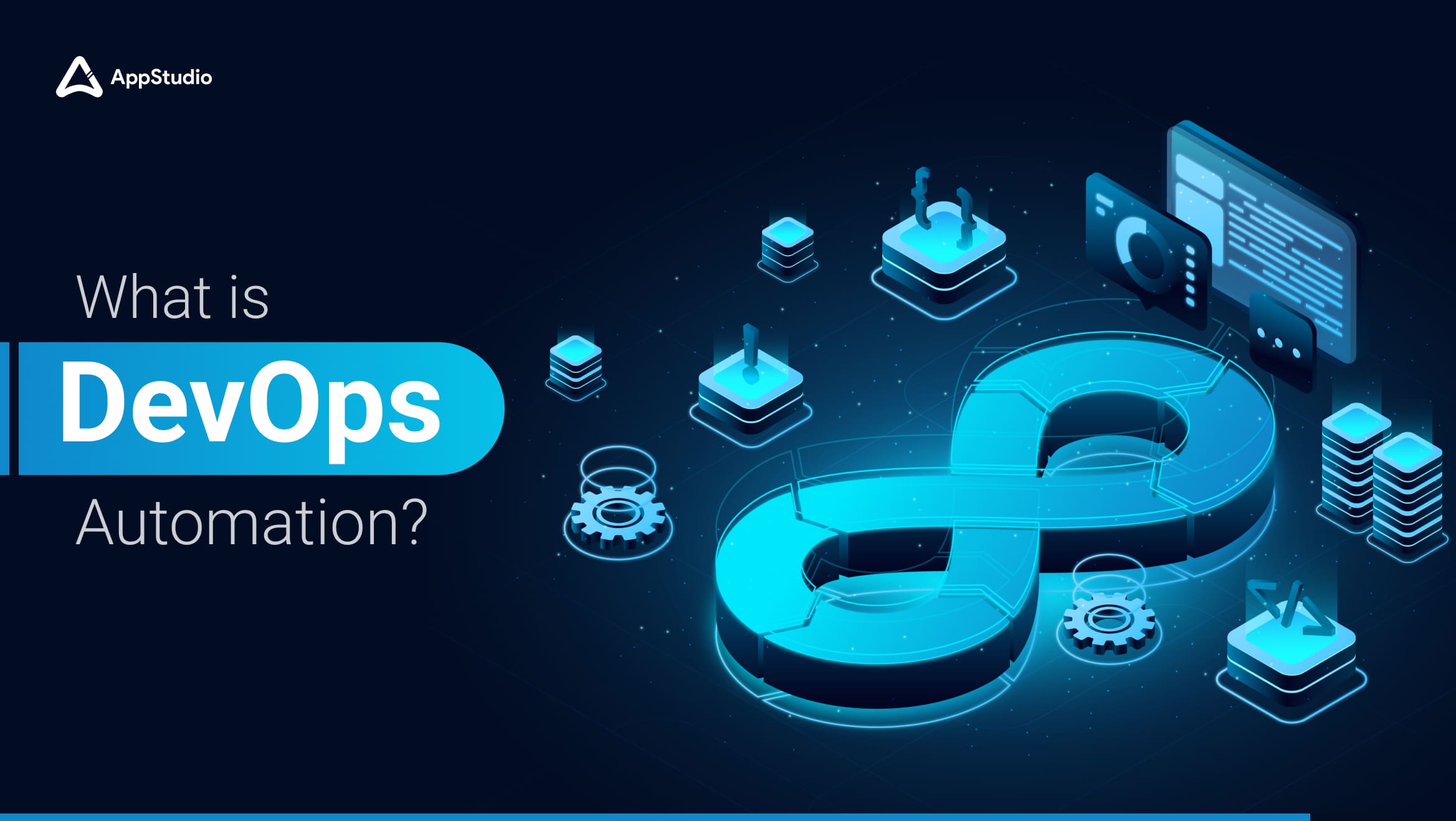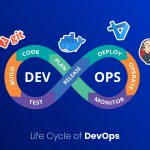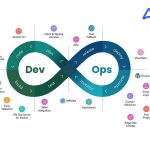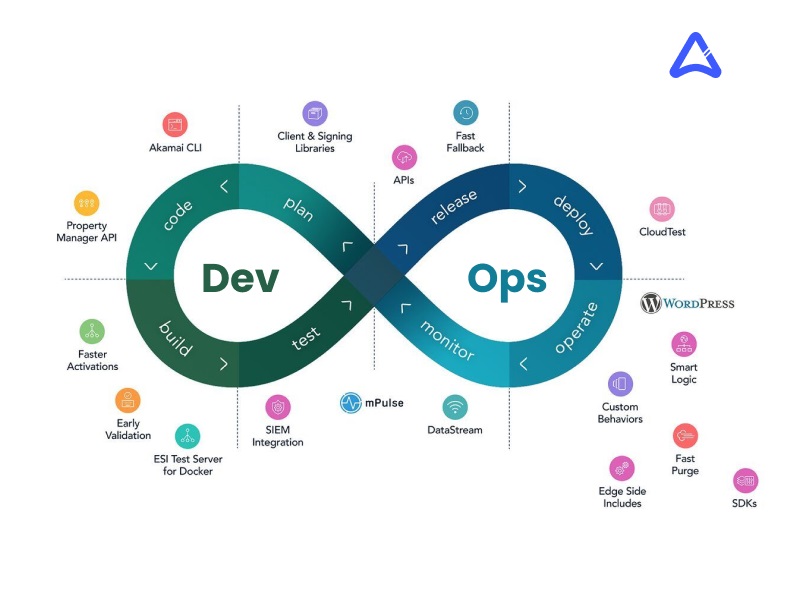DevOps automation uses technology to make tasks easier and faster, reducing the need for human help. This process improves how development and operations teams work together. With DevOps automation, we can get quicker feedback, which helps us update applications in production more efficiently.
DevOps automation ensures that the processes run smoothly by connecting software development with IT operations. This efficiency is essential in today’s fast-paced business environment. The outcome is faster software delivery, fewer errors, and greater overall productivity, allowing us to stay agile and responsive to market demands.
From a technical point of view, DevOps automation supports continuous integration and continuous deployment (CI/CD) pipelines, infrastructure such as code (IaC), automated testing, monitoring, and feedback loops. These components simplify our software development and deployment processes, creating a more effective workflow.
In this complete guide to DevOps automation, we will explore best practices, key tools, and strategies that can help businesses enhance efficiency, improve collaboration, and speed up software delivery. Let’s dive in!
6 DevOps Metrics for Team Success
Successful DevOps automation is not just about running scripts or automating tasks; it’s about making businesses grow. According to the 2021 DevOps report, a majority of DevOps leaders report that extending DevOps to more applications is key to digital transformation. It’s about creating a self-sustaining environment that boosts productivity and resilience.
Tracking specific metrics can be beneficial as your team implements DevOps automation. These metrics will help you gauge your progress and gain the support of any skeptical stakeholders.
Here are some important metrics to monitor:
- Deployment Frequency: This indicates how often the team successfully releases updates to production, reflecting the speed and efficiency of your DevOps process.
- Deployment Speed: This measures the time it takes to deploy a new update after it receives approval.
- Change Failure Rate: This shows the percentage of code changes that result in failures when they go live.
- Mean Time to Recovery (MTTR): This metric assesses how quickly your team can address a service outage or total failure.
- Defect Escape Rate: This tracks the number of issues that bypass testing and emerge after an application is launched.
- Application Availability: This metric evaluates how often an application is operational and accessible to users.
By monitoring these indicators, you can gain valuable insights into your progress and make informed decisions.
Related reading: Future of DevOps and Cloud in the Next 5 Years
Benefits of DevOps Automation
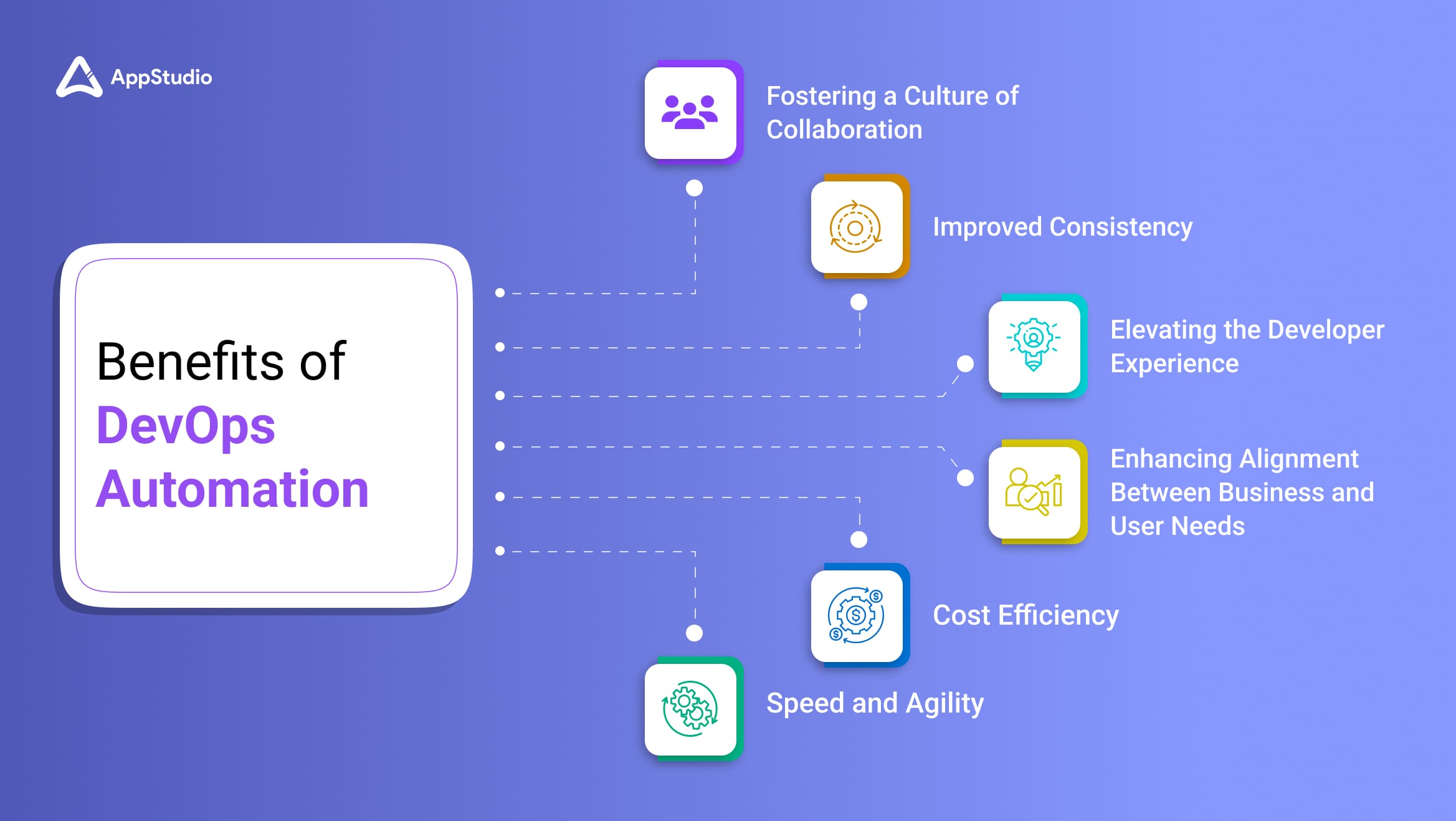
The effects of automation in DevOps are substantial, offering various benefits that enhance efficiency, quality, and scalability. Here are some key advantages of adopting DevOps automation:
Speed and Agility
Automation speeds up repetitive tasks, making developing, testing, and deploying software quicker. This agility helps teams respond faster to market changes and customer feedback.
Improved Consistency
Automated configurations reduce the chances of inconsistencies between different environments, ensuring that deployments are reliable and uniform. This consistency builds trust and satisfaction among users, as customers can expect the same performance across various platforms.
Cost Efficiency
By allowing automation to handle routine tasks, your teams can focus on more important work, helping to lower operational costs. Organizations save money by reducing manual work and minimizing the risk of costly mistakes that can occur when humans are involved.
Enhancing Alignment Between Business and User Needs
Automated validation against essential business metrics ensures that only quality code reaches production. This process not only helps prevent errors but also guarantees that the software aligns with both organizational objectives and user expectations, enhancing overall satisfaction.
Elevating the Developer Experience
Increased automation allows developers to spend less time on tool maintenance and updates. This shift fosters better collaboration between teams, freeing up valuable time for innovation and creative problem-solving, ultimately leading to a more efficient and enjoyable development environment.
Fostering a Culture of Collaboration
Support for DevOps automation signals an organizational commitment to community-building and scalable strategies. Embracing this cultural shift encourages collaboration across teams, fosters a shared vision for success, and empowers employees to contribute actively to the company’s growth and improvement.
The scalability and speed provided by DevOps automation enable us to respond to change more effectively, ultimately delivering better products to your customers. The combination of these benefits prepares your organizations for sustained growth and competitiveness in your respective markets.
Related reading: A Detailed Insight into the Devops Culture
Best Process for DevOps Automation
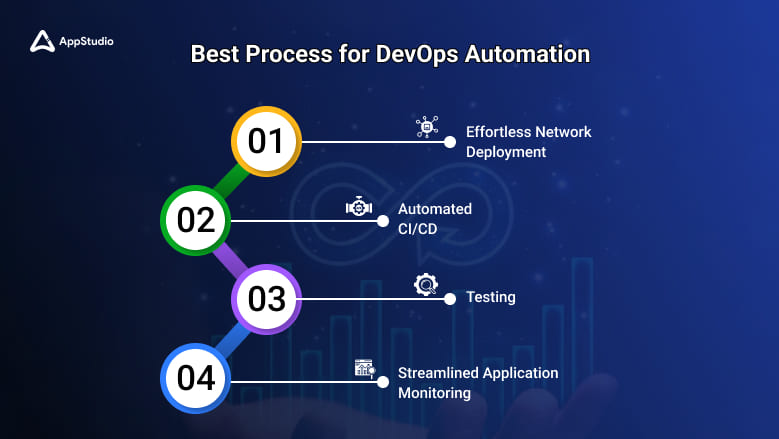
Many DevOps processes gain significant advantages from automation due to their repetitive and complex nature. Key processes that are well-suited for automation include:
Automated CI/CD
Automation in CI/CD pipelines guarantees that code changes are tested and deployed uniformly across environments. Automated testing at various stages, such as unit, integration, and end-to-end tests, allows teams to quickly spot and resolve issues before they reach production.
Testing
Automated testing is vital for maintaining quality in rapid release cycles. By implementing tests throughout various stages, we can quickly identify and fix problems, improving overall software reliability. Automated testing frameworks can run tests on multiple environments at once, significantly speeding up your time to market.
Streamlined Application Monitoring
Automated application and log monitoring provides in-depth insights into performance and quickly addresses issues reported through logs or Digital Experience Management (DEM). The ultimate aim is to ensure 24/7 uninterrupted service accessible from any device, anywhere.
Effortless Network Deployment
Automated network provisioning delivers computing resources on demand using predefined processes, eliminating the need for human intervention. This approach can also facilitate application deployment in software containers, such as Kubernetes, depending on the specific IT solution in use.
A Step-by-Step Guide to DevOps Automation
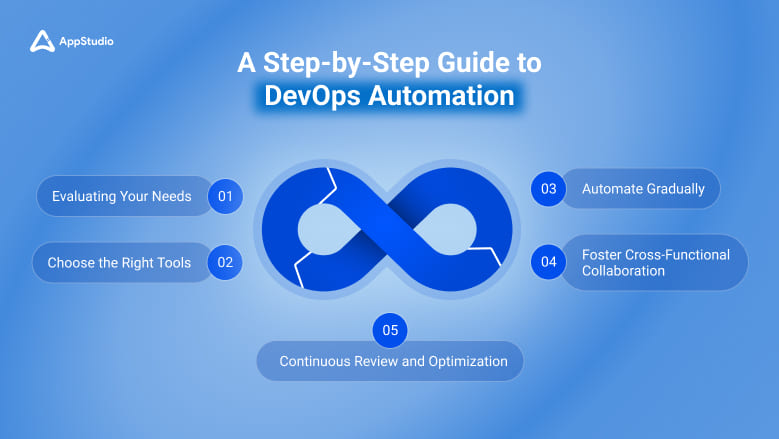
At AppStudio, we recognize that DevOps automation is not a one-size-fits-all journey. To enhance our DevOps lifecycle, we implement strategies like self-service observability, monitoring-as-code, and real-time feedback loops, making it simple for our development and IT teams to integrate observability and insights with just a few clicks. By embedding these processes, we enable teams to rapidly monitor performance, maintain service reliability, and respond quickly to any issues.
Integrating AIOps into cloud strategy is another step toward innovation at AppStudio. Our approach leverages intelligent observability and data-driven insights, which break down organizational silos and improve collaboration, empowering each team to contribute effectively to our shared goals.
Here’s How We Approach DevOps Automation at AppStudio
1. Evaluating Your Needs
We start by examining existing workflows to pinpoint repetitive tasks and areas primed for automation. Involving team members from different areas gives us unique insights, helping us uncover challenges and target improvements effectively.
2. Choose the Right Tools
Selecting the right tools is essential. We consider options like Jenkins for CI/CD, Docker for containerization, and Terraform for Infrastructure-as-Code (IaC), all of which fit seamlessly with our infrastructure to enhance productivity and operational consistency.
3. Automate Gradually
We begin with simpler tasks to demonstrate quick wins, build confidence, and validate the benefits of automation. This incremental approach allows us to refine our automation strategy and progressively tackle more complex workflows.
4. Foster Cross-Functional Collaboration
At AppStudio, we ensure alignment across teams by fostering cross-functional collaboration. This way, everyone understands their role in the automation process, helping to create a cohesive and well-coordinated strategy.
5. Continuous Review and Optimization
Regularly monitoring and gathering feedback on automated processes is crucial. We conduct frequent reviews to identify bottlenecks and optimize as we grow, ensuring our automation strategy remains efficient and continues to meet your evolving needs.
Related reading: A Detailed Insight To DevOps Toolchain
Why DevOps Automation Matters?
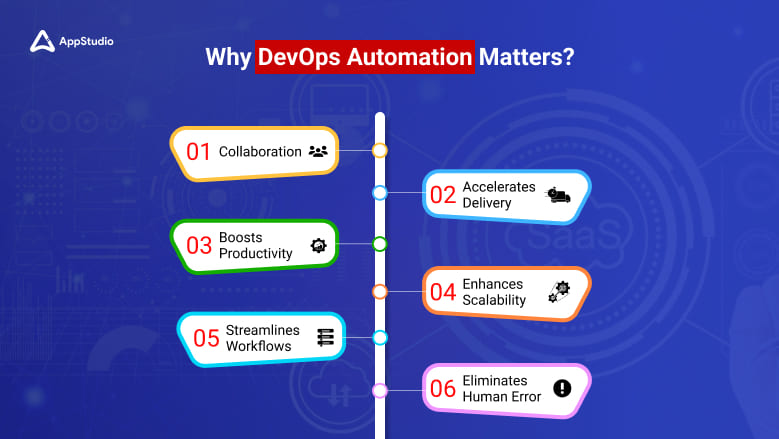
There are numerous reasons why businesses should consider implementing DevOps automation. By automating repetitive tasks, teams can shift their focus to strategic initiatives that enhance customer value and drive innovation. This transition elevates team morale and leads to a more engaged workforce, as employees witness the tangible impact of their contributions on the organization’s success.
Now, let’s look into why DevOps Automation matters.
Encourages Collaboration and Communication
Automating routine tasks allows team members to focus on collaborative and strategic work, strengthening teamwork.
Boosts Productivity
Automation gives developers more time to refine their code, improving work quality and satisfaction.
Streamlines Workflows
Quality assurance steps become automated, reducing team stress and creating smoother, standardized processes.
Accelerates Delivery
Automation paired with declarative configuration speeds up deployment, improving user experience.
Enhances Scalability
Automated systems efficiently handle multiple applications and environments, scaling to meet shifting demands.
Eliminates Human Error
Automation minimizes repetitive tasks, reducing errors and ensuring accuracy throughout development.
Must-Have Features in DevOps Automation

Certain key features are essential for effective DevOps automation and business success. When selecting or implementing tools, it’s advised to prioritize these attributes, as they play a crucial role in achieving optimal outcomes and operational efficiency in DevOps.
Ensuring Data Accuracy
Automated validation catches errors in data and code changes before they impact your strategy.
Comprehensive Change Tracking
A reliable automation platform keeps a detailed audit trail of all configuration changes.
Robust Access Management
Secure access controls protect sensitive information while enabling authorized team members to collaborate effectively.
Capacity for Growth
Automation tools should scale to meet increasing demands, supporting more users, services, and applications as your organization expands.
Seamless Workflow Integration
Effective automation requires tools that integrate smoothly across CI/CD, testing, and monitoring processes.
Enhanced Security Measures
Integrated security features protect data integrity and compliance with automated vulnerability checks during deployment.
Adaptable and Versatile Tools
Solutions should be flexible to accommodate diverse team needs and adjust to changing project requirements.
Related reading: What Is The Importance of DevOps in Mobile App Development?
Top Tools for DevOps Automation
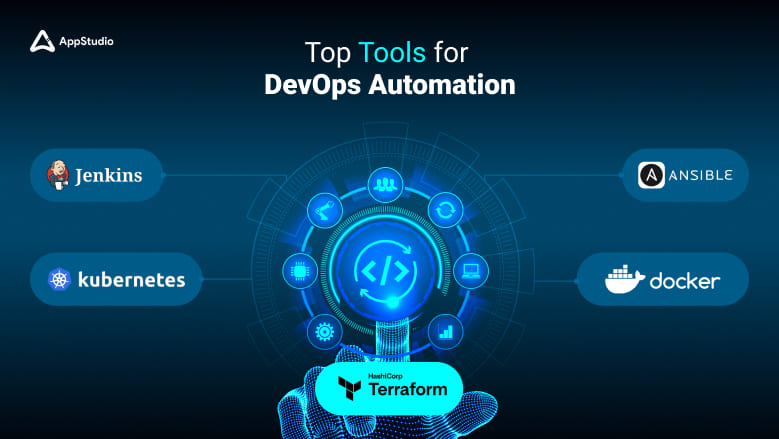
A successful DevOps environment relies on various automation tools, each serving a unique purpose in streamlining processes and optimizing efficiency. Here are some commonly used tools for DevOps automation:
Jenkins
This popular CI/CD tool automates the building, testing, and deployment of code changes, making it a cornerstone of many DevOps pipelines. Its extensive plugin ecosystem allows it to integrate with nearly any tool used in software development.
Docker
Docker’s containerization capabilities ensure consistency across development, testing, and production environments, making deployments more predictable and reliable. By packaging applications and their dependencies into containers, Docker simplifies the deployment process.
Kubernetes
This container orchestration platform automates containerized applications’ deployment, scaling, and management, allowing teams to efficiently manage complex applications in production.
Terraform
This IaC tool enables us to provision and manage infrastructure using code, ensuring consistency and resource control. Terraform’s declarative language allows us to define the desired state of our infrastructure and automatically apply changes.
Ansible
This automation tool streamlines configuration management and application deployment. With Ansible, we can automate complex tasks through simple YAML-based playbooks, making it easy to manage servers and applications.
Overcoming Challenges in DevOps Engineering and Automation
While DevOps automation offers significant benefits, implementing it can still present challenges for many organizations. Common difficulties include integrating with existing systems, adapting team workflows, managing security risks, and bridging skill gaps. Overcoming these obstacles calls for careful planning, collaborative efforts, and continuous training to drive successful automation adoption.
Beyond these, here are some additional challenges and strategies for addressing them:
Resistance to Change
Team members may resist adopting new tools and processes, fearing disruptions to their established workflows. To combat this, we should communicate the benefits of automation clearly and provide training to ease the transition.
Tool Overload
With so many automation tools available, it’s easy to feel overwhelmed by choices. Instead of trying to implement multiple tools at once, we should start with the most critical areas for automation and gradually expand the toolsets.
Integration Difficulties
Integrating new tools with existing systems can be challenging. Ensuring we choose tools with strong integration capabilities will help us create a seamless automation experience.
Lack of Skilled Personnel
Not having the right skills within the team can hinder automation efforts. Investing in training and upskilling can help you build the expertise needed for successful automation, or consult with Appstudio.
Related reading: DevOps: The Complete Guide to Understand DevOps Lifecycle
Conclusion
As we continue to embrace automation, we can expect greater agility, efficiency, and innovation within your teams. Understanding and implementing best practices, tools, and strategies for DevOps automation can empower your organization to adapt quickly to change and maintain a competitive edge in today’s fast-paced digital landscape. By automating repetitive tasks, we free up valuable resources and focus on what matters most: delivering high-quality software that meets customers’ needs!
Frequently Asked Questions
DevOps automation integrates development and operations workflows, automating repetitive tasks like coding, testing, and deployment. This approach increases efficiency, speeds up release cycles, and ensures high-quality, consistent software delivery.
Common tools include Jenkins for CI/CD automation, Kubernetes for container orchestration, and Ansible for configuration management. These tools streamline processes, improve collaboration, and maintain consistency in deployment across different environments.
Automated security checks within the DevOps pipeline allow teams to identify vulnerabilities early, addressing them during the development and testing stages. This proactive security approach reduces risks and maintains application integrity.
Automation allows applications to scale quickly by managing environment setups and load balancing. This ensures that applications handle increased user demand seamlessly, helping businesses stay responsive in high-growth situations.
Automated CI/CD pipelines reduce manual intervention and standardize workflows, leading to reliable deployments. Automated testing and monitoring further ensure that issues are caught and resolved early, maintaining application quality at every release.
Absolutely. DevOps automation can be customized to fit specific workflows, testing requirements, and deployment processes. This flexibility allows businesses to optimize DevOps for their unique application needs and operational goals.
